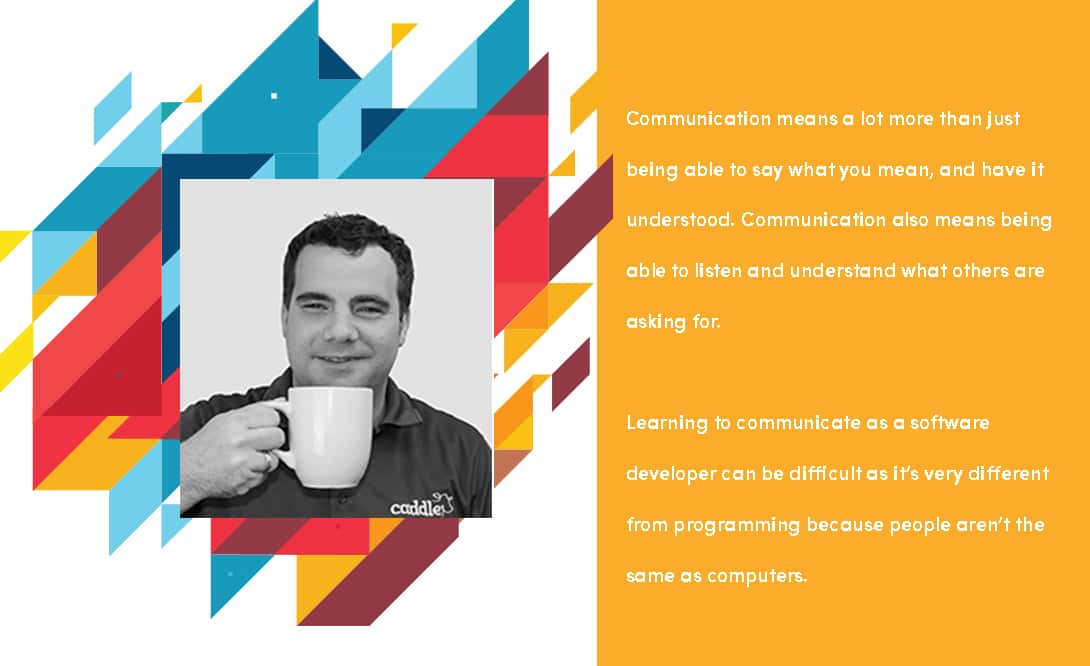Why I started Caddle
Why I started Caddle
For seven years, I worked in Marketing and Sales at SC Johnson and we had one simple but critical pain point: we didn’t understand our consumers as well as we needed to.
In the digital age, brand loyalty is low, the competition fierce and ad-blocking technology is booming . The CPG (Consumer Packaged Goods) industry is cutthroat. We were constantly struggling to keep up with a fickle customer base and win the race to get the next best innovation on the shelves.
In this environment, you need fresh and fast market insights to ensure your brand survives in today’s CPG landscape, but we had no way of getting those with shrinking budgets and archaic, bloated insights providers. Sourcing intelligence from multinational market research firms or focus groups wasn’t an option. Because it took time to gather, compile and publish the data in traditional market research reports, it was often dated and fragmented. Focus groups are expensive and time-consuming to organize and manage. We needed insights within days of spotting an opportunity, not months. By the time we got those insights, the opportunity had passed.

A Better Way
I knew there had to be a better way, and that there was a need for businesses to have recent, up-to-the-minute data on their potential and current customers at an affordable price. My first thought was to build a mobile app that would reward consumers for their engagement with cash back on the products they’re interested in.
Consumers would answer surveys to identify brands they wanted to connect with. In return, brands would get to engage directly with consumers.
‘Imagine having hundreds of thousands of consumers at our fingertips,’ I thought to myself. ‘Instead of using dated or US research, we could have direct access to our consumer to get the insights that would drive our brands.’
At SC Johnson, this would have cost me five (maybe even six) figures and months to get the research.
I spent the next two years thinking about my idea. Eventually, my wife (my girlfriend at the time) gave me a clear ultimatum: “You need to do it or you need to shut up.”
The Deadline
That was enough motivation for me. I gave myself a deadline of May 1, 2015 to make it happen or move on. Two weeks prior to my deadline, I watched an inspiring documentary about (the late) Steve Jobs and Steve Wozniak, the founders of Apple. Watching that film about two pioneers who grew what would become a multi-billion dollar company out of their garage was exciting and inspiring. I thought, ‘I want to do this, but I need a sign.’
A few days before my deadline, I attended a training seminar in Chicago for SC Johnson (my employer at the time). During my flight back from Chicago to Buffalo, I discovered, The Woz was on my flight! I instantly recognized him from the documentary. But one thing was missing: there was no Apple watch on his wrist.
As we checked our bags through security, I seized a window of opportunity and tapped Mr. Wozniak on the shoulder to tell him my story. In reply, he said, “I don’t need to understand it. The fact is, you have the passion to do it. It’s not whether it fails or not. It’s going to be that you’re glad you did it and failed rather than the regret of not doing it at all.”
This was the ‘sign’ I’d been waiting for! Steve’s encouragement during that impromptu chat inspired me to sell some investment properties and hire Symetric, a local web and graphic design agency, to build the Caddle app.

From there, things took off. I quit my job at SC Johnson and launched Caddle in 2015. We attracted customers such as PepsiCo, Mars, and General Mills.
Dragons’ Den
An appearance on the popular CBC series Dragons’ Den resulted in four out of five dragons making a $125,000 investment in the company for 28 percent equity in the business (off-screen, we rejected the deal, and instead raised capital on more favourable terms with friends and family). Mick Higgins, our chief marketing officer, describes us as “ad blocking kryptonite.”
People listened to and believed in our pitch, and the market conditions continue to validate it. Thanks to our partners and the consumers who continue to support us, we engage everyone from millennial moms to tech evangelists, sports enthusiasts, and more – much faster than any old school focus group.
We launched and continue to grow our team in St. Catharines. Today, we have a team of 20 employees and a massive user base enabling brands to get the insights they need faster than any other platform.
The Most Important Skill for Software Developers Isn't Writing Code
Brian Cline – Chief Technology Officer
As a software developer, I’ve always felt the most important skill to have was being able to write code and being able to multitask. Over the years, I’ve realized that while writing code is important but it’s definitely not the most important thing in developing software.
Multitasking isn’t actually important either, and it’s very difficult for it to actually be done in practice because writing software requires a laser focus. So, what is the most important skill then?
I believe that a lot of my personal failures as a programmer were the result of communication problems and not usually technical reasons. The most important skill in software development is being able to communicate clearly.

What is Communication?
Communication means a lot more than just being able to say what you mean, and have it understood. Communication also means being able to listen and understand what others are asking for. Learning to communicate as a software developer can be difficult as it’s very different from programming because people aren’t the same as computers.
I bet you communicate every day whether it be with your colleagues or your manager. Like programming, the best way to get better at communicating is to better intentionally practice it and to do things that we wouldn’t normally do.
Most likely, a third to half of the work day is spent communicating with others whether it be in written or verbal form. It’s a really good idea to start practicing being good, compassionate, and passionate person. So, how do you do this?
Here’s a couple of principles I’ve been trying to follow that I feel are pretty helpful:
- Listen
- Choose to encourage over criticizing.
- When criticizing it must be constructive
- Put yourself in the other person’s shoes (yes this is definitely cliché).
Listening
I believe that poor listening habits are the primary cause of many of my daily problems and probably they’re the cause of your problems too. I think the big thing to do is to really focus on listening and not limiting what you hear.
Focus on listening for the content, meaning, and feeling that that other person is expressing. It’s super important to just listen to understand and avoid interrupting, commenting or disagreeing. Wait through the moments of silence in case the other person isn’t done finishing a thought.
As left-brained analytical people, we all have a desire to fix the problem or concern and not listen to the entire message. This unfortunately doesn’t help with listening which results in things being missed.

Choose to encourage over criticizing
Feedback is essential to a being a good software developer and for running a well-functioning team. I’ve learned that only commenting on the poor-quality work results in the other programmer producing worse quality work.
Criticism usually ends up putting the other person on the defensive which usually results in a win for absolutely nobody. We developers almost never actually work alone, we are usually on teams of 3 – 7 people and spend lots of time reading and reviewing other’s work.
When criticizing it must be constructive
As a young leader in the Canadian Forces, it was constantly banged into my head that when providing feedback to my staff it had to be constructive. Feedback had to something they could actually change.
Feedback like “you’re an idiot” won’t help any. It won’t help that person to grow, it will discourage them and cause friction.
In the military we always told to use the feedback sandwich which means a Praise, Improvement and a Praise. The feedback should look something like this:
Focus on a particular strength of the person. It could be that they’re a really hard worker, or that you appreciate the task getting done so quickly. The criticism, basically what needs improvement. The feedback needs to be constructive though, you need to show how you would do it. Focus on another strength of the person or you could use the same positive feedback as was started with, and then talk about how much better it could be with the criticism being followed.

Put yourself in the other person’s shoes
“Putting yourself in the other person’s shoes” is a lot more than a cheesy cliché or quote from a book like To Kill a Mockingbird. It means that you need to have empathy and understand the feelings that the other person is having. Resolving conflict through empathy is a vital communication skill.
Empathy is recognizing other people’s emotions and going beyond your own concerns. People aren’t generally being evil, unkind or stubborn. They are reacting to previous experience or the knowledge they have.
Good communication is what will drive growth whether it be personal growth or career growth. Terrible communication will cause your personal life and career to stagnate.
Other Resources
The Developer on Fire podcast was a podcast that had a fairly large impact on me. There’s probably close to a dozen episodes where the guests speak about communication being important.
Cannabis Research: Change is Afoot
on Canadian "High" Streets
Change is Afoot on Canadian “High” Streets
On October 17, 2018 Canada became the second country in the world (after Uruguay), and the first G7 and G20 nation to legalize recreational cannabis for adult use. While medical cannabis has been legal in Canada since 2001 (and available for purchase online after new legislation in 2014), a federally regulated recreational cannabis market, made legal by the passing of the Cannabis Act, represents the beginning of a completely new industry, full of unknowns. How much supply is necessary to meet the demands of Canadian consumers? What consumption methods will be most popular? Will high CBD strains be more popular with older generations of consumers?
While hypotheses and biases could easily be used to justify an answer to any one of these questions, neither industry stakeholders, special interest groups, citizen activists, or policy makers can rely on instinct alone to understand and operate in this new industry.

Don’t Market to the Average – Why Understanding the Canadian Market Matters
While States like Washington, California, Oregon, and Vermont offer some insights in to a post-legalization economy, understanding the specifics of consumer preference, perception, and consumption patterns in the Canadian market is fundamental to the success of cannabis growers, retailers, and brands in this country. While understand generalized consumption patterns is important for high-level decision making, cannabis brands that are looking to build relationships with consumers know that brand loyalty (and profit) relies on an obsessive understanding of their target audience. As with other verticals in the CPG industry, data-driven insights and decision making are the fuel that keeps the customer experience optimization fires burning.
Consumer Data Scarcity
“Consumer data scarcity is something that is being felt by brands across the board” says former Tokyo Smoke Brand Manager Taylor Keefe, now Brand Manager at Detonate Group Detonate Cannabis Agency in Markham. “In Ontario, for example, LP’s (Licensed Producers) and brands have some paid access to data from the OCS website. But that’s high-level, purchase data. That’s not enough of the picture to build sales and marketing strategies, to really understand what the consumer wants and what the consumer needs.”
Canadian’s perceptions of this new market are demonstrably and obviously different from those of our neighbours to the South. Research by Elle Wadsworth and David Hammond from the University of Waterloo School of Public Health and Health Systems show that young people in the United States and Canada have differing views on cannabis, most notably on perceptions of harm and impact on health. Research by industry specific media & lifestyle brand Civilized in partnership with PSB Research note that Canadian and American stoners are likely to differ in their demographic breakdown, consumption methods, and smoking rituals as well.

Bring your Buds, Bud – Why Data Matters for Consumers Too
Given the tight restrictions around cannabis marketing in Canada, brands have to find new and creative ways to engage with consumers. For now, packaging and branding restrictions ensure that brands trying to differentiate themselves have to rely on an educated consumer, or, where possible, have to provide consumers with the data they need to make informed purchasing decisions.
In an industry that has for decades existed in the back alleys, dark parking lots, and (literal) margins of Canadian society, data about cannabis (it’s effects, how to consume, what to consume, etc.) has largely been denied to curious consumers unwilling to operate within the Black Market. Now, those consumers (whether first timers or those returning to the plant) are faced with the daunting task of educating themselves. While some brands like Tweed and Tokyo Smoke are using their retail locations for consultations or educational sessions, not every pot brand in the country has that luxury.
“If you look at the industry in Manitoba right now, it’s kind of the Holy Grail. LP’s are in control from seed to sale, and the retail locations give brands the opportunity to connect with consumers, gather feedback in-store, and ultimately, build relationships and brand trust with consumers” says Keefe, “I think that’s one thing that Tokyo Smoke was able to do really well pre-legalization.”
Education is key
Although Tokyo Smoke’s flagship coffee shops in Toronto didn’t sell any bud (they still don’t), having a retail location gave consumers the opportunity to connect with the brand. “Where brands and LP’s have that direct interaction with their consumers, both parties win. At Tokyo Smoke we had Cannabis Yoga Night’s, classes about cooking with cannabis, even workshops on how to roll joints. When you can talk to your consumer face to face, it’s not just collecting feedback, it’s sharing information, it’s educating each other” Keefe says.
Brands that can use data to drive business decisions and educate consumers simultaneously will find themselves on the winning side of the brand battle while being at the right place, at the right time, with the right information for consumers looking to get a better understanding of this new industry. Brands using data to understand their customers know where they need to be and what they need to say to establish the relationships that will ultimately mean the success or failure of their business.

Change is neither Good or Bad. It Simply Is.
The introduction of cannabis as a new industry represents a fundamental change, full of uncertainty and opportunity. It was once said that change “can be greeted with terror or joy – a tantrum that says ‘I want it the way it was,’ or a dance that says ‘Look, something new.'”
As with all societal changes, be it technological, market-driven, moral, spiritual, political, or banal, informed decision making allows relevant stakeholders to cut through misinformation and “fake news” to make good, rational decisions. Even large, established CPG brands facing change and disruption must come to recognize the value of data-driven decision making. In a LinkedIn post, The Kraft Heinz Company President Nina Barton says that
We need to be strategic curators, anticipating and delivering on their wants and needs. Brands that step up, will win. Those that don’t, will be unseated.
Like the pioneers, explorers, and adventurers of old, marketers know that when it comes to navigating change, uncertainty, and the potential for new opportunities, having a map is a great way to make sure you get where you want to go, and you get there fast. Data is that map that can lead burgeoning new cannabis brands to the promised land of customer loyalty, brand health, and profit margins.
Godspeed.
Loyalty
How restaurants are building relationships
In his classic Kitchen Confidential, the late, great Anthony Bourdain famously revealed that the best day to eat out is Tuesday – for three key reasons:
- The best chefs are off duty on Monday, return rested and ready to go on Tuesday.
- Fresh ingredients are typically delivered to restaurants on Tuesday (also Thursday and Saturday).
- Chefs prefer to cook for weekday guests than weekenders, because weekday guests are the true regulars – weekends typically track in tourists.

Restaurant Logic reinforces the importance of prioritizing regulars: they provide stable income, will champion you and recommend your restaurant to others, and are more willing to provide honest, helpful feedback to you, because they know you.
In a recent Caddle survey, 60% of respondents see loyalty and rewards programs as an important factor in their dining decision. Quality food and quality service are always important factors when it comes to food, but a loyalty program can seal the deal and help build your relationships with regulars.

Clutch reports that loyalty members have a 26% higher annual spend, 10% increase in purchase frequency, 15% higher average order value, and 25% higher engagement versus non-members. Upserve states that 82% of loyalty members refer at least one person and spend an average of $2.14 more than non-members, which is vital in the quick service restaurant industry.
Upserve recommends offering a VIP experience to loyalty members, while Webstaurant Store suggests offering incentives such as a chance to win a free meal or gift certificate, to consider loyalty programs that integrate with your Point of Sale system, and to utilize the program to improve traffic during quieter periods throughout the week. Finally, Webstaurant recommends to make sure your rewards program is attainable, favourable, and above all else – simple.
Dollars for data
How researchers are rewarding users
The products and services we use every day are made increasingly better by the data we provide marketers, brands, and researchers. But do we deserve more?
In today’s world, everything from your puppy portraits to the route your ride share driver takes are being tracked. Sporting a step counter, pre-ordering your pumpkin spice latte on-the-go, even the sultry sounds you select on Spotify – in almost every aspect of our daily lives, meaningful data is being collected and influencing the future products and services sold back to us.

The data we provide [ideally] result in more accurate, tailored solutions provided back, but should we be rewarded further for the data we’re providing? When Caddle users were asked this, 89% said “of course!” The research and reward model is one that Caddle has helped pioneer and polish in Canada, and thanks to peers following a similar model, the world is becoming fairer for users sharing tidbits of their preferences online.
Here at Caddle, we employ a simple and effective cashback model: businesses pay to feature ads and ask questions to our users, our users collect cash for watching ads and answering questions, and we earn a small amount in handling the overall transaction and providing an easy-to-use platform. The benefits of our solution are immediate: businesses pay for ads that actually get attention, and users are rewarded for their valuable time and data.

Other Canadian companies have embraced this collegial approach to data, too. Carrot Rewards focuses on wellness, integrating with fitness apps like Fitbit and then rewarding users for steps via existing loyalty programs such as Aeroplan, Petro Canada Petro Points and Cineplex Scene. Along the way, users have the opportunity to earn more rewards via surveys (commissioned by external partners), not dissimilar to Caddle.
Peer-to-peer goods trading network Bunz recently embraced both cryptocurrency and the research/reward model with the release of BTZ (pronounced like “bits”), a currency that Bunz users can use in trades or at local businesses who accept it for payment. Users can further earn BTZ by answering single-question surveys from Bunz each day.

Whether or not global social media giants like Facebook and Instagram will adopt similar reward-focused research models remains to be seen, but as publications like The New York Times and The Economist are poised to help challenge the digital world, we’ll keep doing our part.
Social media sites and why it's hard to leave
Earlier this year, Caddle surveyed users on their relationships with social media and awareness of the Facebook and Cambridge Analytica scandal. Not surprisingly, Facebook remains the most-used platform among users from Boomers (64%) to Generation X (64%) to Millennials (59%), while Gen Z users are favouring Instagram at 36% versus Facebook at 23%.

In March, USA Today reported the trend of users parting from Facebook and prioritizing Instagram for social networking. Citing Pew Research Centre, USA Today highlighted that “…800 million people log in to Instagram at least once a month, 500 million of them every day… 35% of US adults use Instagram, an increase of 7% from 2016.” This comes as no surprise to TechCrunch editor Josh Constine, who explains that, “Every social network has a half-life. Eventually parents get on it, grandparents get on it, your boss gets on it. And you don’t want to hang out with them.”
…800 million people log in to Instagram at least once a month, 500 million of them every day… 35% of US adults use Instagram, an increase of 7% from 2016.

And yet, with the dominance of Facebook and the rise of its subsidiary Instagram, many Instagram users are unaware of the connection and their privacy risks with the revelation of the Cambridge Analytica scandal. CBS News reported in April that almost 57% of Americans do not know that Facebook owns Instagram. The lack of representation regarding this relationship is purely intentional, too – to this day, there are no evident branding ties between Facebook and Instagram platforms, nor Facebook’s other biggest subsidiaries such as WhatsApp and Oculus VR. This may change with the recent exit of top Instagram executives Kevin Systrom and Mike Krieger following a contentious year between Instagram and Facebook; The Verge is predicting “the end of Instagram as we know it.”

If you’re an avid Instagram user and think you may be affected by the Facebook security breach, Tech Crunch provides a thorough guide on what to know and what to do next.
Cannabis stigma - is there a change on the way?
is there a change on the way?
In a Caddle survey of approximately 10,000 Canadian non-cannabis users earlier this year, our team found that 77% of respondents had no intention of trying cannabis once legalized in Canada. When asked about potential reasons why they might potentially try cannabis, 49% of respondents maintained that they simply would never try it. 43% were against legalization of recreational cannabis in Canada, 53% either disagreed or strongly disagreed that legalization would be good for society, and 54% of respondents felt there is a negative stigma still associated with cannabis use.

What are the stigmas?
Last year, the Government of Canada commissioned an official Canadian cannabis survey, including both users and non-users from 16 years and up. In the survey of 9,215 Canadians, 77% of respondents felt that cannabis could be habit forming, and while nearly half indicated positive effects on mood, anxiety, sleep and creativity, the majority of respondents felt that cannabis can negatively affect motivation (57%), memory (58%), concentration (59%), attention (60%) and decision making (62%). Interestingly, while alcohol was widely considered the most socially acceptable substance, more respondents felt cannabis was socially acceptable (28%) than tobacco (19%).
Is legalization driving the stoner stereotype away?
In a 2017 study performed by U.S.-based cannabis research firm BDS Analytics, the researchers found that the average household income among Californian consumers is $93,800 compared to $74,350 for non-users. Californian users are more likely to hold master’s degrees, and Colorado users are more likely to be employed full-time compared to non-users. In the same study, BDS Analytics found that users from California and Colorado (two of the nine United States where cannabis is currently legal) are more likely to consider themselves very social, and are more likely to enjoy the outdoors and volunteer their time compared to non-users from the same states.

How will the stigma turn a corner?
For the non-users surveyed by Caddle, the leading reasons why they might try recreational cannabis once legalized included pain relief and relaxation (14%), curiosity (12%), and reduced stress and anxiety (10%). Wellness is a constant reason for interest and usage according to most research available so far. In a report by Deloitte, the top two reasons for using recreational cannabis include relaxation and sleep (66%), and to reduce stress or anxiety (62%).
Read more from the Caddle Cannabis Survey
Canadian identity: Seven similarities of the common Canadian
Although known for embracing the many cultures that make up Canada’s mosaic, it appears our multicultural population share more in common than one might expect. In a recent Caddle survey, 70% of respondents felt they have much in common with Canadians from other provinces – and here are seven of the many traits we share:
1. Frenzied fans of hockey
Invented in Canada, hockey is our official national sport. Canadian-born players continue to make up the majority of the National Hockey League at 41.6%, and our national teams have dominated on the international stage for generations.

2. Notoriously nice
If there are common characteristics non-Canadians cite of Canadians, it’s that we’re warm, welcoming, and polite – if not to a fault. In fact, without exaggeration, we’re likely to apologize even if you’re the one truly at fault. Sorry about that.
3. Hankerin’ for Hortons
Truly ubiquitous, Tim Hortons is the largest fast food restaurant and most popular coffee in Canada. Even the most hard-hearted coffee hipster will concede that Tims/Timmies coffee is iconic, beloved across the country, and a definite road trip staple.
4. Cottage country crazy
Home of approximately 60% of the world’s lakes, it’s no surprise that Canadians prefer to spend summer weekends at the lake.

5. Comedic claim to fame
From Catherine O’Hara to Eugene Levy, Jim Carrey to Mike Myers, Michael Cera to Seth Rogan – Canada is a historic hotbed for comedic talent.
6. Desired differentiation
If there’s one not-so-nice quality many Canadians share, it’s an almost passive-aggressive need to be known as distinctly not American – especially in our travels abroad.
7. Eh B C’s
For a word so short, there’s no shortage of its use. We often do not realize how much we say “eh” until we step foot in another English-speaking country where it’s not commonly used. Go figure, eh?
Caddle Announces New Nielsen Partnership
Caddle Announces New Nielsen Partnership
We are pleased to announce our inaugural membership as a featured partner in the Nielsen Connected Partner Program in Canada. The Nielsen Connected Partner program will allow clients and approved Connected Partners to spend less time on data management and data alignment and more time focused on garnering value from Connected Partner insights.

Connected Partner Program
Grounded in Nielsen data, the Connected Partner Program will allow Connected Partners and clients to bridge their insights through a mutual data source and integrate Connected Partner tools and technology into existing workflows. The result is a solution that will enrich the capabilities and insights for both clients and Connected Partners, with every interaction.
“Caddle is thrilled to be named a Nielsen Connected Partner. As Nielsen is an industry leader, it was an obvious next step for our business to join this initiative,” says Ransom Hawley, CEO of Caddle.
Caddle is an innovative research company, providing consumer insights through our Mobile Focus Group platform. By leveraging our joint assets, we’ll be able to collaborate on innovative solutions, ultimately, offering better data solutions and insights for our clients.
Testing Ideas
Caddle allows you to test your ideas in real-time through a mobile consumer research platform that offers users cash-back to connect with your products and services through polls, ads, social media and rich e-coupons. In return you will gain powerful consumer insights that can be used to increase distribution, convert consumer that purchase competitors, and improve targeting & measurement of programmatic advertising.
Through the Connected Partner Program, Nielsen’s data will be integrated to provide a more comprehensive view of your most valuable consumers and their category.
Looking for more information on the Neilsen Connected Partner Program? Looking for more information about Caddle?
